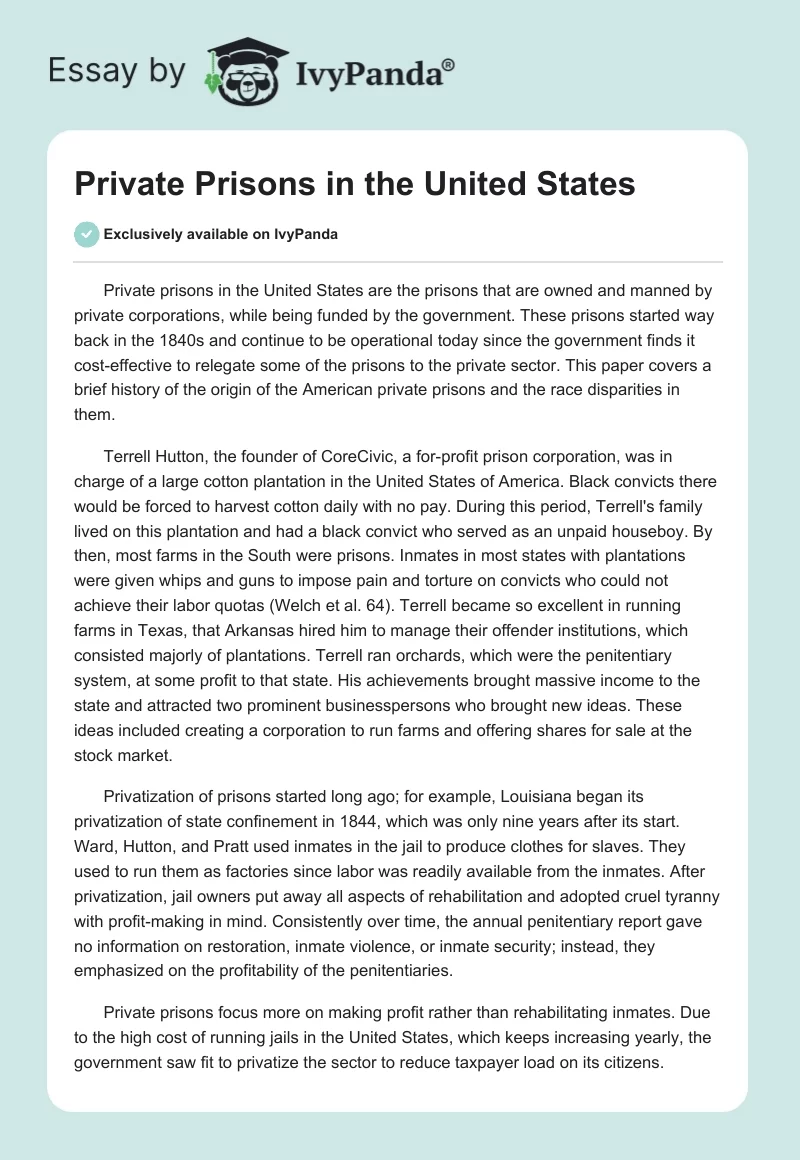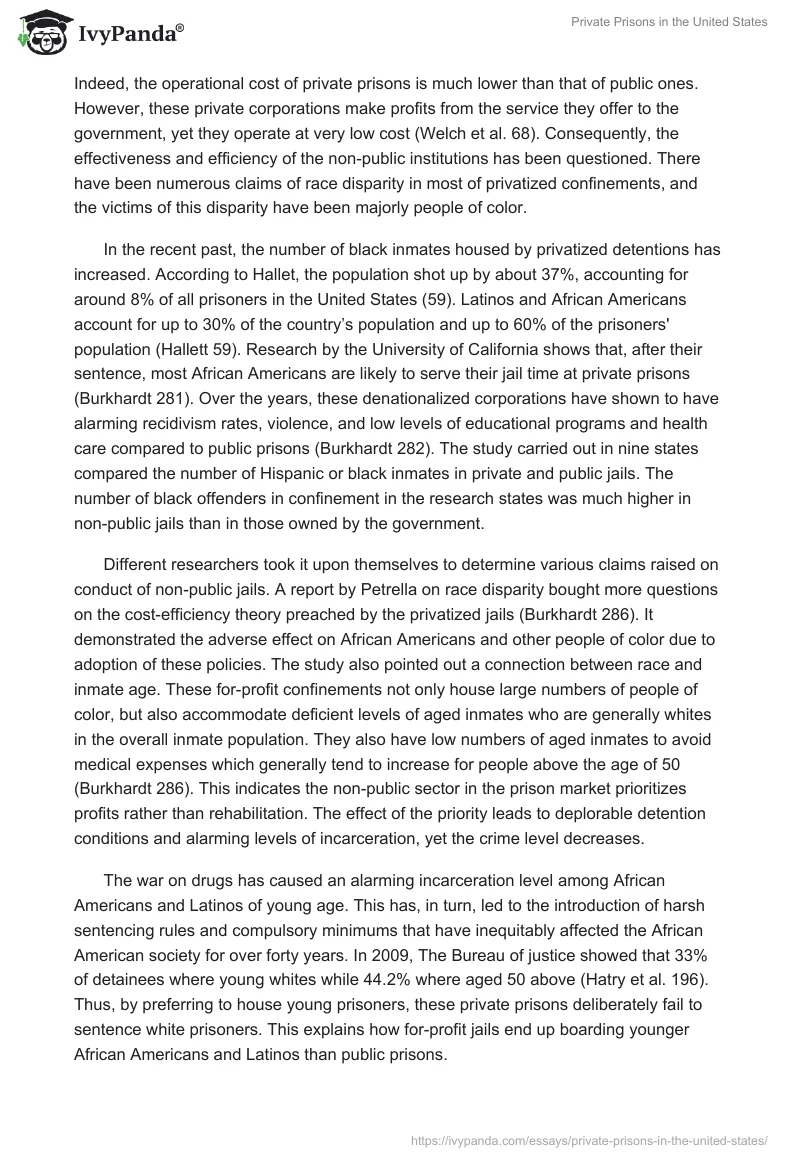Private prisons in the United States are the prisons that are owned and manned by private corporations, while being funded by the government. These prisons started way back in the 1840s and continue to be operational today since the government finds it cost-effective to relegate some of the prisons to the private sector. This paper covers a brief history of the origin of the American private prisons and the race disparities in them.
Terrell Hutton, the founder of CoreCivic, a for-profit prison corporation, was in charge of a large cotton plantation in the United States of America. Black convicts there would be forced to harvest cotton daily with no pay. During this period, Terrell’s family lived on this plantation and had a black convict who served as an unpaid houseboy. By then, most farms in the South were prisons. Inmates in most states with plantations were given whips and guns to impose pain and torture on convicts who could not achieve their labor quotas (Welch et al. 64). Terrell became so excellent in running farms in Texas, that Arkansas hired him to manage their offender institutions, which consisted majorly of plantations. Terrell ran orchards, which were the penitentiary system, at some profit to that state. His achievements brought massive income to the state and attracted two prominent businesspersons who brought new ideas. These ideas included creating a corporation to run farms and offering shares for sale at the stock market.
Privatization of prisons started long ago; for example, Louisiana began its privatization of state confinement in 1844, which was only nine years after its start. Ward, Hutton, and Pratt used inmates in the jail to produce clothes for slaves. They used to run them as factories since labor was readily available from the inmates. After privatization, jail owners put away all aspects of rehabilitation and adopted cruel tyranny with profit-making in mind. Consistently over time, the annual penitentiary report gave no information on restoration, inmate violence, or inmate security; instead, they emphasized on the profitability of the penitentiaries.
Private prisons focus more on making profit rather than rehabilitating inmates. Due to the high cost of running jails in the United States, which keeps increasing yearly, the government saw fit to privatize the sector to reduce taxpayer load on its citizens. Indeed, the operational cost of private prisons is much lower than that of public ones. However, these private corporations make profits from the service they offer to the government, yet they operate at very low cost (Welch et al. 68). Consequently, the effectiveness and efficiency of the non-public institutions has been questioned. There have been numerous claims of race disparity in most of privatized confinements, and the victims of this disparity have been majorly people of color.
In the recent past, the number of black inmates housed by privatized detentions has increased. According to Hallet, the population shot up by about 37%, accounting for around 8% of all prisoners in the United States (59). Latinos and African Americans account for up to 30% of the country’s population and up to 60% of the prisoners’ population (Hallett 59). Research by the University of California shows that, after their sentence, most African Americans are likely to serve their jail time at private prisons (Burkhardt 281). Over the years, these denationalized corporations have shown to have alarming recidivism rates, violence, and low levels of educational programs and health care compared to public prisons (Burkhardt 282). The study carried out in nine states compared the number of Hispanic or black inmates in private and public jails. The number of black offenders in confinement in the research states was much higher in non-public jails than in those owned by the government.
Different researchers took it upon themselves to determine various claims raised on conduct of non-public jails. A report by Petrella on race disparity bought more questions on the cost-efficiency theory preached by the privatized jails (Burkhardt 286). It demonstrated the adverse effect on African Americans and other people of color due to adoption of these policies. The study also pointed out a connection between race and inmate age. These for-profit confinements not only house large numbers of people of color, but also accommodate deficient levels of aged inmates who are generally whites in the overall inmate population. They also have low numbers of aged inmates to avoid medical expenses which generally tend to increase for people above the age of 50 (Burkhardt 286). This indicates the non-public sector in the prison market prioritizes profits rather than rehabilitation. The effect of the priority leads to deplorable detention conditions and alarming levels of incarceration, yet the crime level decreases.
The war on drugs has caused an alarming incarceration level among African Americans and Latinos of young age. This has, in turn, led to the introduction of harsh sentencing rules and compulsory minimums that have inequitably affected the African American society for over forty years. In 2009, The Bureau of justice showed that 33% of detainees where young whites while 44.2% where aged 50 above (Hatry et al. 196). Thus, by preferring to house young prisoners, these private prisons deliberately fail to sentence white prisoners. This explains how for-profit jails end up boarding younger African Americans and Latinos than public prisons.
For-profit prisons constantly claim that their efficient programs lead to the low operating costs as compared to public prisons. On the contrary, data show that these detentions do not save through the claimed efficiency but, by selecting healthy inmates. By choosing a specific profile of offenders, these privatized institutions are just like schools that only recruit excellent performing schools, and there is no basis for efficiency. Due to the profile of the offenders they chose, there is race disparity and in turn inmates of color end up being subjected to misery in the for-profit penitentiaries.
Works Cited
Burkhardt, Brett C. “Private Prisons in Public Discourse: Measuring Moral Legitimacy”. Sociological Focus, vol. 47, no. 4, 2018.
Hallett, Michael A. Private Prisons in America. University of Illinois Press, 2017.
Hatry, Harry et al. “Comparison of Privately and Publicly Operated Corrections Facilities in Kentucky and Massachusetts.” Privatizing Correctional Institutions, 2017.
Welch, Michael. “Book Review: Corrections & Collections: Architectures for Art and Crime”. International Criminal Justice Review, vol. 27, no. 3, 2017.


